1993 BUICK CENTURY towing
[x] Cancel search: towingPage 79 of 324
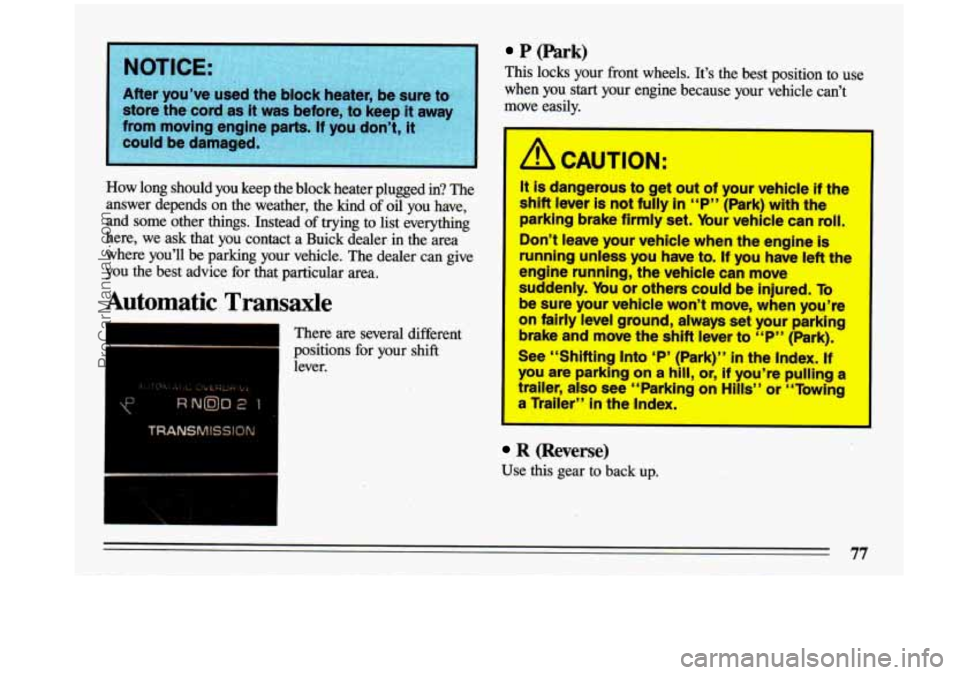
NOTICE:
After you’ve
How long should you keep the block heater plugged in? The
answer depends on the weather, the kind of
oil you have,
and some other things. Instead of trying
to list everything
here, we ask that you contact a Buick dealer, in the area
where you’ll be parking your vehicle. The dealer can give
you the best advice for that particular area.
Automatic .Transaxle
There are several different
positions for your
shift
lever.
P (Park)
This locks your front wheels. It’s the best position to use\
when you
start your engine because your vehicle can’t
move easily.
I- -
I a CAUTION:
It is dangerous to get out of your vehicle if the
shift lever is
not fully in “P” (Park) with the
parking brake firmly set.
Your vehicle can roll.
Don’t leave your vehicle when the engine is
running unless you have to. If you have left the
engine running, the vehicle can move
suddenly. You
or others could be injured. To I
be sure your vehicle won’t move, when you’re
on fairly level
ground, always set your parking
brake and move the shift lever to “P” (Park).
See “Shifting
Into ‘P’ (Park)” in the Index. If
you are parking
on a hill, or, if you’re pulling a
trailer, also see “Parking
on Hills” or “Towing
a Trailer”
in the Index.
R (Reverse)
Use this gear to back up.
ProCarManuals.com
Page 81 of 324
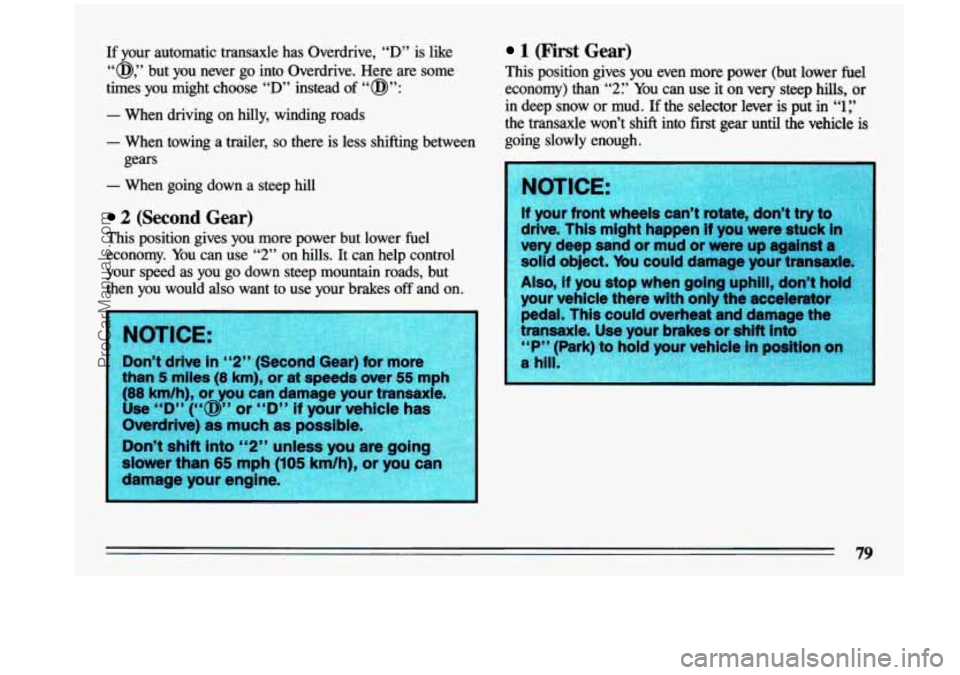
If your automatic transaxle has Overdrive, “D” is like
“a,” but you never go into Overdrive. Here are some
times you might choose
“D” instead of “@”:
- When driving on hilly, winding roads
- When towing a trailer, so there is less shifting between
gears
- When going down a steep hill
2 (Second Gear)
This position gives you more power but lower fuel
economy. You can use
“2” on hills. It can help control
your speed as you go down steep mountain roads, but
then you would also want to use your brakes off and on.
1 (First Gear)
This position gives you even more power (but lower fuel
economy) than 2. You can use it on very steep hills, or
in deep snow or mud. If the selector lever is put in “1 i’
the transaxle won’t shift into first gear until the vehicle is
going slowly enough.
bb 99
79
ProCarManuals.com
Page 82 of 324
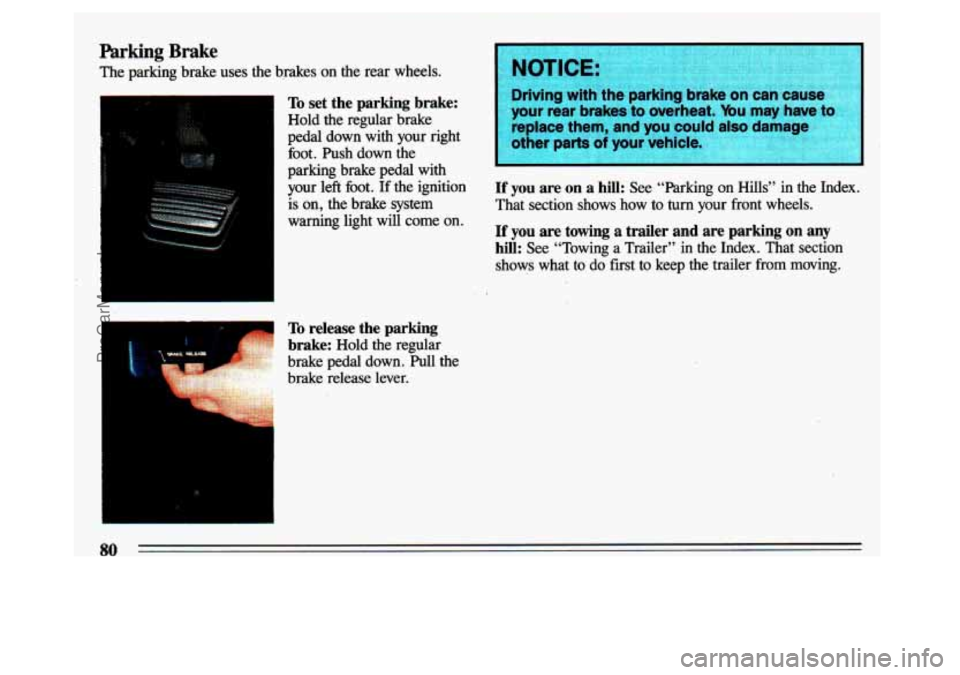
Parking Brake
The parking brake uses the brakes on the rear wheels.
I
To set the parking brake:
Hold the regular brake
pedal down with your right
foot. Push down the
parking brake pedal with
your left foot.
If the ignition
is on, the brake system
I warning light will come on.
L
I
To release the parking
brake:
Hold the regular
brake pedal down. Pull the
brake release lever.
NOTICE:
Driving with thiparl ‘g brake or )use
your rear brakesto oveFheat. ybu may have
-
replace them, and you could alse damage
other parts
of your vehicle.
If you are on a hill: See “Parking on Hills” in the Index.
That section shows
how to turn your front wheels.
If you are towing a trailer and are parking on any
hill: See “Towing a Trailer” in the Index. That section
shows what to do first to keep the trailer from
moving.
80
ProCarManuals.com
Page 83 of 324
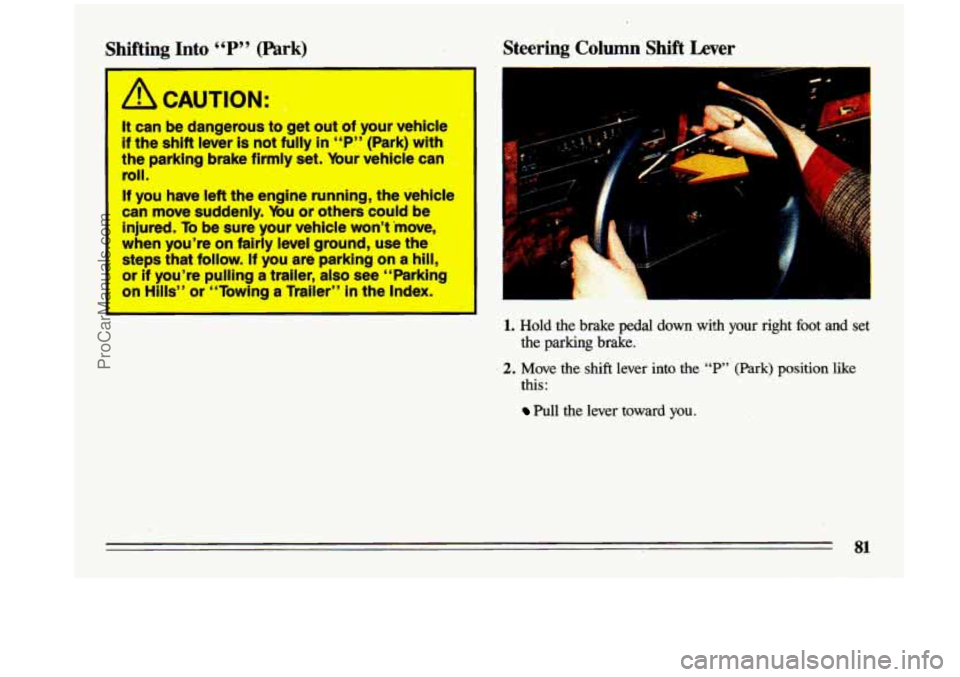
Shifting Into “P” (Park)
,3
/i CAUTION: ~
It can be dangerous to get out of your vehlcle
if the shift lever is not fully in “P” (Park) with ,
the parking brake firmly set. bur vehicle can -.
roll.
If you have left the engine runnin.g, the vehicle
can move suddenly. ybu
or others could be
injured. To be sure your vehicle won’t inwe,
when you’re on fairly level ground, Use the ‘
steps that follow. If you are parking on a hill,
or if you’m pulling a trailer, also see. “Parking
on Hills” or “Towing B Trailer” in the Index.
Steering Column Shift Lever
1. Hold the brake pedal down with your right foot and set
the parking brake.
2. Move the shift lever into the “P” (Park) position like
this:
Pull the lever toward you.
81
ProCarManuals.com
Page 86 of 324
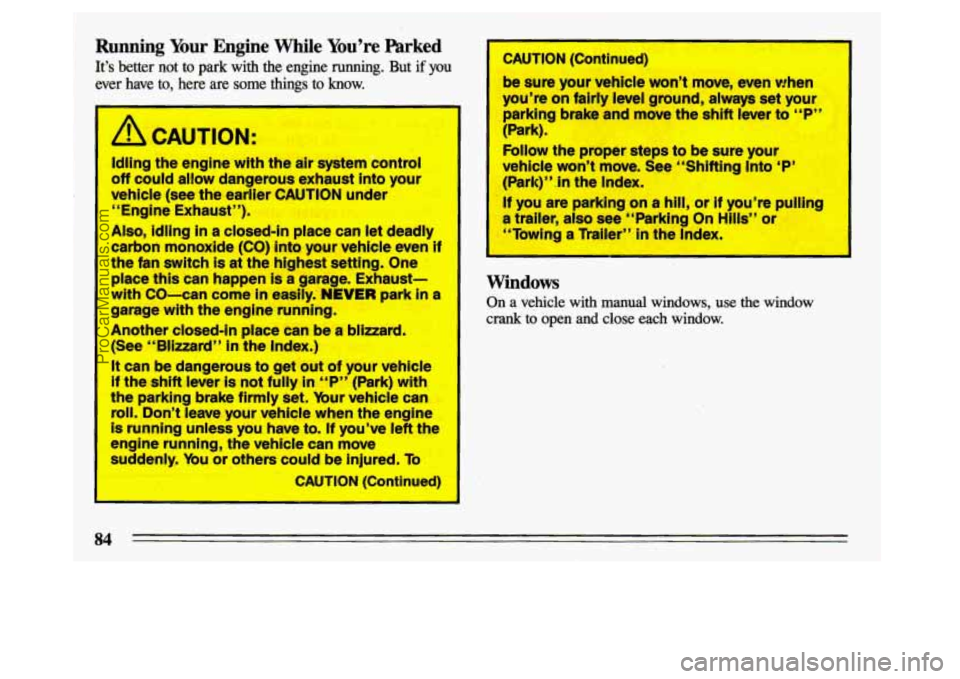
Running Your Engine While You’re Parked
It’s better not to park with the engine running. But if you
ever have to, here are some things to know.
1
I a CAUTION: I
Idling the engine with the air system “control
off could allow dangerous exhaust into your
vehicle (see the earlier
CAUTION under
“Engine Exhaust”).
Also, idling In a closed-in place can let deadly
carbon monoxide
(CO) into your vehicle even if
the fan switch is at the hlghest setting. One
place this can happen
is a garage. Exhaust-. -
with C0-n come in easily.’ NEVER park in a
garage wlth the engine running.
Another closed-in place can
be a blizzard.
It can be dpngeroua to get out of your vehicle
If the shift lever is not fully On “P” (Park) wlth
the parking
brake firmly set. bur vehicle can
roll. Don’t leave your vehicle when the engine
Os runnhg unless you. have to. If you’ve left the
engine running, the vehicle can move
suddenly.
Nu or others could be injured. To
I
I
I (See “Blizzard” In.the Index.)
CAUTION (Continued)
- - - -
I CAUTION (C __ ____ Jued) ..
be sureyour vehicle won’t move, even when
you’re on fairly level ground, always set your
parking
brake and move the shift lever to “P”,
(Park).
Follow the proper steps to be &re your
vehicle won’t move.
See “Shifting Into ‘P’
(Park)”.in the Index.
If you are parking on
a hill, or if you’re pulling
a trailer, also see “Parking On Hills” or
“Towing
a Thiler” in the Index.
i
Windows
On a vehicle with manual windows, use the window
crank
to open and close each window.
84
ProCarManuals.com
Page 111 of 324

Volts Gage (Option)
When your engine is not
running, but
the ignition is
on (in the “Run” position),
the gage shows your
battery’s state of charge
in
DC volts. When the engine
is running, the gage shows
the condition of the
charging system. Readings
between the red warning
zones indicate the normal
operating range.
Readings in either red
warning zone indicate a possible problem in the electrical
system. Have your vehicle serviced immediately.
Brake System Warning Light
Your Buick‘s hydraulic
brake system is divided into
two parts. If one part isn’t working, the other part can still work and stop you. For
good braking, though, you
need both parts working
well.
If the warning light
goes on, there could be a
brake problem. Have your
brake system inspected right away.
This light should come on
as you start the vehicle. If it doesn’t come on then, have it
fixed
so it will be ready to warn you if there’s a problem.
This light will also come on when you set your parking
brake, and will stay on if your parking brake doesn’t release
fully. If it stays on after your parking brake is
fully released, it means you have a brake problem.
If the light comes on while driving, pull
off the road and
stop carefully.
You may notice that the pedal is harder to
push. Or, the pedal may go closer to -the floor. It may take
longer to stop. If the light is still on, have the vehicle towed
for service. (See “Towing Your Buick” in the Index.)
109
ProCarManuals.com
Page 135 of 324
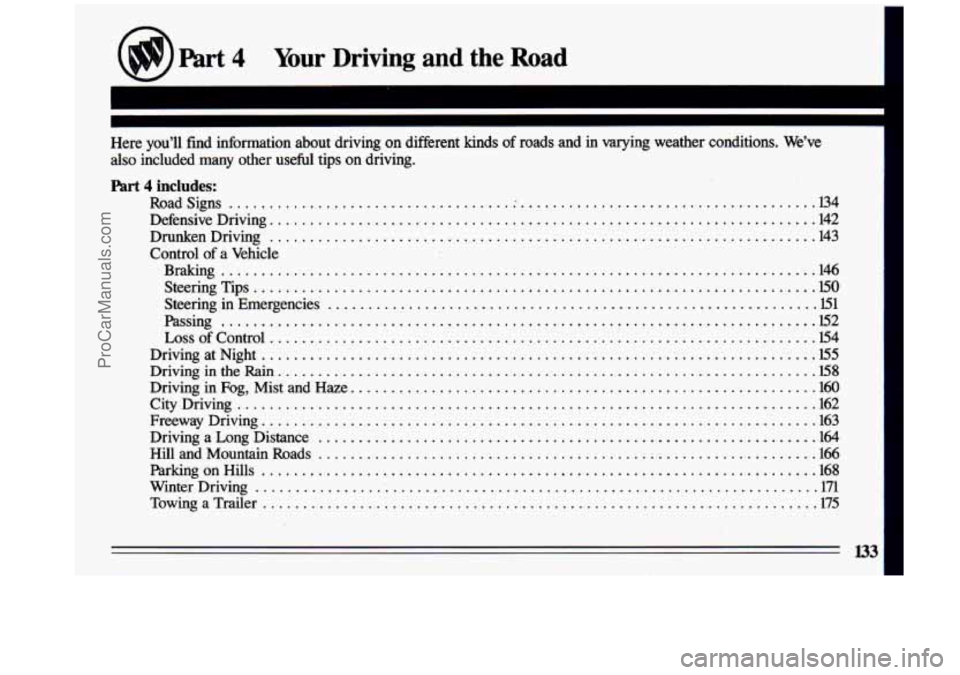
Part 4 Your Driving and the Road
~~ ~~~~ ~~ ~
Here you’ll find information about driving on different kinds of roads and in varying weather conditions . We’ve
also included many other useful tips on driving
.
Part 4 includes:
Roadsigns ........................................................................\
. 134
DefensiveDriving
.................................................................... 142
Control of a Vehicle
DrunkenDriving
.................................................................. 143
Braking
........................................................................\
.. 146
SteeringTips
...................................................................... ~0
Steering in Emergencies ............................................................. E1
Passing ........................................................................\
.. 152
LossofControl .................................................................... E4
DrivingatNight ..................................................................... E5
DrivingintheRain ................................................................... ~8
Driving in Fog, Mist and Haze .......................................................... 160
CityDriving ........................................................................\
162
FreewayDriving
..................................................................... 163
DrivingaLongDistance
.............................................................. 1~ .
HillandMountainRoads 166
ParkingonHills
..................................................................... 168
WinterDriving
...................................................................... 171
TowingaTrailer
..................................................................... 175
-
..............................................................
ProCarManuals.com
Page 177 of 324
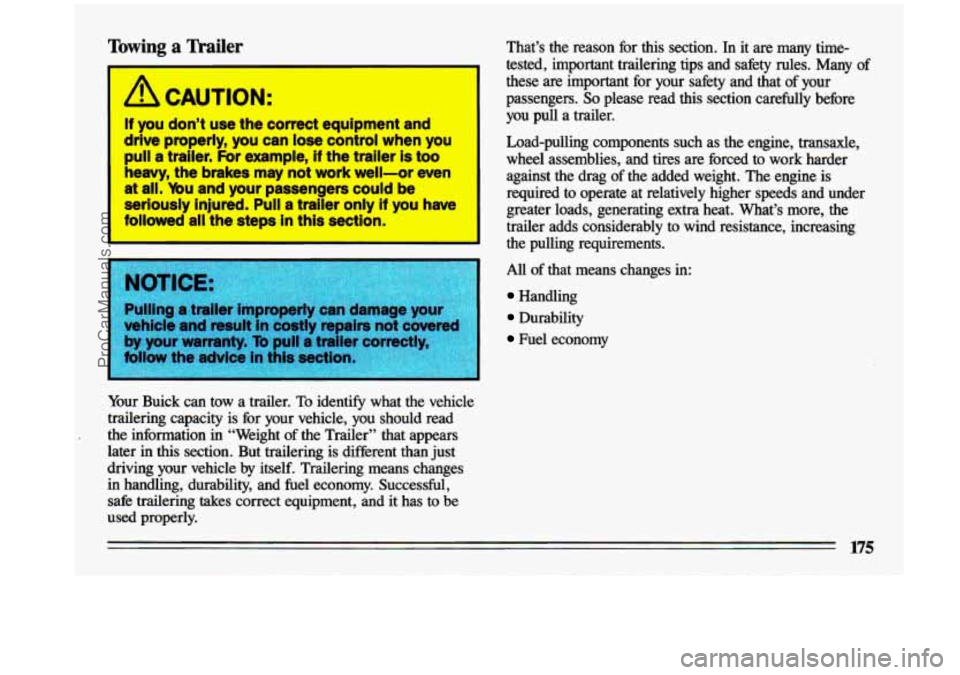
Towing a Trailer
A CAUTION:
If you don’t use the correct equipment and
drive properly, you can lose control when you
pull a traller. For example, If the trailer is too
heavy, the brakes may not work well--or wen
at all. Mu and your passengets could be
seriously Injured. Pull a trailer only if you have
followed all the steps in this section.
hicle and result
Your Buick can tow a trailer. To identify what the vehicle
trailering capacity is for your vehicle, you should read
the information in “Weight of the Trailer” that appears
later
in this section. But trailering is different than just
driving your vehicle
by itself. Trailering means changes
in handling, durability, and fuel economy. Successful,
safe trailering
takes correct equipment, and it has to be
used properly. That’s the reason for this section.
In it are many time-
tested, important trailering tips and safety rules. Many
of
these are important for your safety and that of your
passengers.
So please read this section carefully before
you pull a trailer.
Load-pulling components such as the engine, transaxle,
wheel assemblies, and tires are forced to work harder against the drag of the added weight. The engine is
required to operate at relatively higher speeds and under
greater loads, generating extra heat. What’s more, the
trailer adds considerably
to wind resistance, increasing
the pulling requirements.
All of that means changes in:
Handling
Durability
Fuel economy
175
ProCarManuals.com